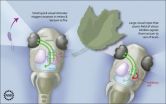(Press-News.org) CORVALLIS, Ore. – Engineers at Oregon State University have discovered a new method to speed the production rate of nanoparticles by 500 times, an advance that could play an important role in making nanotechnology products more commercially practical.
The approach uses an arrayed microchannel reactor and a "laminated architecture" in which many sheets, each with thousands of microchannels in them, are stacked in parallel to provide a high volume of production and excellent control of the processes involved.
Applications could be possible in improved sensors, medical imaging, electronics, and even solar energy or biomedical uses when the same strategy is applied to abundant materials such as copper, zinc or tin.
A patent has been applied for, university officials say. The work, just published in the journal Nanotechnology, was done in the research group of Brian Paul, a professor in the OSU School of Mechanical, Industrial and Manufacturing Engineering.
"A number of new and important types of nanoparticles have been developed with microtechnology approaches, which often use very small microfluidic devices," said Chih-hung Chang, a professor in the OSU School of Chemical, Biological and Environmental Engineering, and principal investigator on the study.
"It had been thought that commercial production might be as simple as just grouping hundreds of these small devices together," Chang said. "But with all the supporting equipment you need, things like pumps and temperature controls, it really wasn't that easy. Scaling things up to commercial volumes can be quite challenging."
The new approach created by a research team of five engineers at OSU used a microreactor with the new architecture that produced "undecagold nanoclusters" hundreds of times faster than conventional "batch synthesis" processes that might have been used.
"In part because it's faster and more efficient, this process is also more environmentally sensitive, using fewer solvents and less energy," Chang said. "This could be very significant in helping to commercialize nanotech products, where you need high volumes, high quality and low costs."
This research, Chang said, created nanoparticles based on gold, but the same concept should be applicable to other materials as well. By lowering the cost of production, even the gold nanoclusters may find applications, he said, because the cost of the gold needed to make them is actually just a tiny fraction of the overall cost of the finished product.
Nanoparticles are extraordinarily tiny groups of atoms and compounds that, because of their extremely small size and large surface areas, can have unusual characteristics that make them valuable for many industrial, electronic, medical or energy applications.
INFORMATION:
This work was supported by the Safer Nanomaterials and Nanomanufacturing Initiative of the Oregon Nanoscience and Microtechnologies Institute, or ONAMI. Funding was also provided by the Air Force Research Laboratory and the W.M. Keck Foundation.
The journal publication the story is based on is available online: http://hdl.handle.net/1957/18930
Microreactor speeds nanotech particle production by 500 times
2010-11-02
ELSE PRESS RELEASES FROM THIS DATE:
Diverse surgeons initiative effectively increases underrepresented minorities in academic surgery
2010-11-02
CHICAGO (November 1, 2010) – According to a report published in the October issue of the Journal of the American College of Surgeons, a grant-funded program tailored to provide advanced minimally invasive surgery skills to young, underrepresented minority surgeons, is helping address shortages of minority faculty members at US medical institutions.
The report states that the Diverse Surgeons Initiative (DSI) has helped 86 percent of graduates in the program acquire fellowship training. These outcomes surpassed the 2005 national percentage of fifth-year residents in academic ...
Inhaled steroids increase diabetes risk, say Lady Davis Institute researchers
2010-11-02
Patients taking inhaled corticosteroids are at increased risk of developing type 2 diabetes, and more so with higher doses, say researchers at the Jewish General Hospital's Lady Davis Institute for Medical Research (LDI) In Montreal. The risk is of special concern for patients suffering from chronic obstructive pulmonary disorder (COPD), and much less significant for asthmatics.
"These medications are very effective in asthma, so the benefits clearly outweigh the risk for asthmatics," said Dr. Samy Suissa, Director of the Centre for Clinical Epidemiology at the LDI, and ...
Common stomach bacteria may fight off inflammatory bowel disease caused by Salmonella
2010-11-02
Ann Arbor, Mich. — Helicobacter pylori, a common stomach bacterium, reduced the severity of inflammation of the colon caused by Salmonella in mice, according to research from U-M Medical School scientists.
More than half the people in the world are infected with H. pylori, although it is very unusual to find it in the United States. But this research shows there may be an inflammation control benefit to hosting the H. pylori infection, says Peter Higgins, M.D., Ph.D., M.Sc., lead author of the study published last week in the journal Inflammatory Bowel Diseases.
"If ...
In the job hunt, people do lie, but honesty pays off, study finds
2010-11-02
Honesty pays off, according to a new study of job seekers. When job applicants were warned that a pre-employment test could detect fake responses, they gave more honest answers -- a result that could improve their chances of being hired. Results were published in the human resources journal Applied HRM Research.
"People may be tempted to make themselves look as attractive as possible to employers, but honesty is always the best policy, since many pre-employment tests have ways to spot fakers," said Chris Wright, associate professor of psychology at San Francisco State ...
The zebrafish's neural circuit prevents it from biting off more than it can chew
2010-11-02
Between alerting us to danger and allowing us to spot prey, vision keeps many animals, including humans, alive. But exactly how does this important sense work, and why is it easier for us to spot movement of small objects in our field of vision, than to notice other things? The complexity of the neural network that supports vision has long baffled scientists.
Now, with a new technology and support from the National Science Foundation, Claire Wyart in Ehud Isacoff's lab at the University of California at Berkeley and Filo Del Bene at Herwig Baier's lab at the University ...
New data from Phase 3 studies showed superior SVR (viral cure) rates achieved with telaprevir-based combination therapy in people with hepatitis C, regardless of race or stage of liver disease
2010-11-02
Boston, MA, October 30, 2010 – Vertex Pharmaceuticals Incorporated (Nasdaq: VRTX) today announced new data from its Phase 3 studies of people with genotype 1 chronic hepatitis C who have not been treated previously. In these studies, the majority of people achieved superior sustained viral response (SVR or viral cure) rates with a telaprevir-based combination regimen, compared to current therapies, regardless of race/ethnicity or stage of liver fibrosis (factors known to limit response to current hepatitis C treatments). Patients in the ADVANCE and ILLUMINATE studies were ...
Study improves accuracy of models for predicting ozone levels in urban areas
2010-11-02
A team of scientists has, for the first time, completely characterized an important chemical reaction that is critical to the formation of ground-level ozone in urban areas. The team's results indicate that computer models may be underestimating ozone levels in urban areas during episodes of poor air quality (smoggy days) by as much as five to 10 percent.
Ground level ozone poses significant health hazards to people, animals and plants; is the primary ingredient of smog; and gives polluted air its characteristic odor. It is known that even small increases in ozone concentrations ...
A discovery could be important for the therapy of lymphoma and leukemia
2010-11-02
A recent scientific discovery made by researchers at the Institut de recherches cliniques de Montréal (IRCM) led by Dr. Javier Marcelo Di Noia, Director of the Mechanisms and Genetic Diversity research unit, was published online today by The Journal of Experimental Medicine. The team identified a mechanism regulating activation-induced deaminase (AID), which could be important for the therapy of some types of lymphoma and leukemia.
AID is a B-lymphocyte enzyme that creates deliberate mutations in the DNA encoding antibodies, which helps produce an appropriate immune ...
Research explores lung cancer among pediatric cancer patients
2010-11-02
Because primary lung adenocarcinoma is exceedingly rare in the pediatric population, it is difficult to properly classify certain lung tumors in children and adolescents. While anecdotal reports of pediatric patients with lung cancer lesions exist, little research has been conducted to link the disease in children to similar pulmonary malignancies in adults. Through an assessment of clinical, tissue-based and molecular data for pediatric lung cancer, research published in the November edition of the Journal of Thoracic Oncology determined that pulmonary lesions found in ...
VIMS scientists help solve mystery of 'alien pod'
2010-11-02
Tracy Collier, an employee at Home Technologies in Newport News, Virginia, was walking her employer's Westie around the Center's manmade lake on Thursday when she saw a large, mysterious blob floating in the water.
Co-worker Charlie Schmuck says "The lake is behind our office. Tracy was walking by the lake, saw the object, and asked everyone else to come out and take a look."
Tracy thought it was "a huge dead snake."
Charlie thought it "looked like some weird underwater fungus, like the ones that explode when you poke them."
Perhaps because it was just a few days ...

